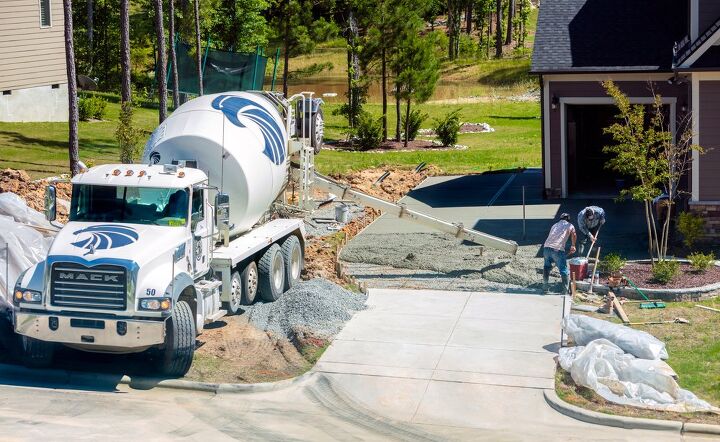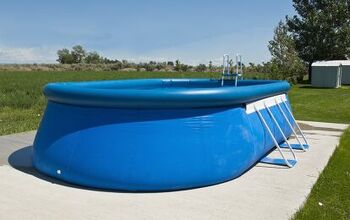How Long Before You Can Drive On Concrete? (Find Out Now!)

Asphalt is a more affordable way to install a new driveway, but concrete is well worth considering. Concrete driveways last 50% to 60% longer than asphalt driveways, and they add to curb appeal. The key to getting a return on your investment is to let the concrete cure.
You can drive on poured concrete after 7 days. Be especially careful, though. Concrete doesn’t fully cure for 28 days. If you drive on it too soon, the concrete will crack, or you may end up with an uneven surface. If you use concrete pavers for your driveway, you can drive on it right away.
Let’s take a look at how concrete cures and how to fix common problems with concrete driveways.
Do You Need Concrete, Brick, or Stone Pros?
Get free, zero-commitment quotes from pro contractors near you.

What is Cured Concrete?
Cured concrete is a natural chemical process that happens after you pour fresh concrete. Concrete is a mixture of water, cement, and aggregate materials, such as gravel or sand. Drying and curing are not the same. Concrete dries within 24 to 48 hours, but it is not strong enough to withstand everyday use. Curing is a process that requires proper humidity and temperature, as well as time.
Why is Curing Important for Concrete?
Curing does a few things. First, exposing fresh concrete to sunlight and wind lowers the water content in the material. As a result, the concrete shrinks. You end up with a smaller driveway than what was poured into the forms.
Second, giving your concrete time to cure allows for the chemical processes that bond the materials in the concrete. This helps to prevent damage to the concrete from weight, vibration, and impacts. If you use the driveway before the materials bond, the concrete cracks.
How Long Does It Take for Concrete to Cure?
There is no clear timeline for curing concrete. As a general rule, it is best to give the material about 28 days to cure. The actual timeline depends on relative humidity, temperature of the concrete, sunlight, wind, and weather conditions. Concrete cures slower in environments with more extreme climate conditions, such as where it is dry, hot, or where humidity levels are high.
Concrete After 24 to 48 Hours
In the first 24 to 48 hours after you pour concrete, the cement starts to settle. This brings water to the surface of the concrete. The moisture evaporates due to sunlight and wind. Drying of concrete should not be rushed. Plastic covers and other tools are used to manage water loss. If the moisture content is reduced too quickly, the concrete is brittle and vulnerable to cracks.
Concrete After 2 to 3 Days
After the concrete is cured for 2 to 3 days, you can walk on your driveway. The compressive strength is a little more than 60%. The ideal compressive strength for concrete is about 85% to 90% for a driveway.
Concrete After 6 to 7 Days
After 6 to 7 days, concrete reaches a compressive strength of about 65% to 70%. This is when it is safe to drive on the concrete.
Concrete After 14 to 28 Days
At 14 days, concrete reaches a compressive strength of a little more than 80%. After 28 days, the concrete has the ideal compressive strength of 85% to 90%.
What are Cement Pavers?
Cement pavers are pre-fabricated pieces of concrete that are used for driveways. You can drive on pavers right away.
Why Seal a Concrete Driveway
Using a concrete driveway sealer prevents moisture from penetrating the material. You should seal your driveway after it is fully cured, and every four to five years. When you seal the concrete, repair any cracks or holes with a slurry of cement and water. Let it sit for 24 to 48 hours. Next, apply two coats of concrete sealer.
How to Stop a Concrete Driveway from Cracking
The reason why a concrete driveway cracks is because the material shrinks. When the concrete was poured, there wasn’t enough humidity in the air. Prevent a concrete driveway from cracking by monitoring the moisture content. Put plastic over the concrete for the first 1 to 2 days.
Concrete Driveway Repair
Repair a concrete driveway with a mixture of water and cement. Fill in the cracks and holes. Make sure that the slurry is even with the original concrete.
Concrete Driveway Resurfacing
If your concrete driveway is looking a bit aged, apply a layer of concrete coating. Let it dry for 24 to 48 hours. If you want to add color to your driveway, tint the coating.
Related Questions
Why are there tire marks on my new driveway?
Tires leave marks on concrete when the rubber is hot. Remove tire marks from concrete by sanding, pressure washing, and using chemicals that break down the rubber.
How much does a concrete driveway cost?
A concrete driveway costs $5 to $7 per square foot. If you want to color your driveway or have a textured finish, it will cost $8 to $18 per square foot. Custom concrete driveways cost more.
Why is my concrete driveway lifting?
Lifting of a concrete driveway is typically caused by roots or erosion. Remove the concrete and roots. Level out the soil, and pour fresh concrete.
Do You Need Concrete, Brick, or Stone Pros?
Get free, zero-commitment quotes from pro contractors near you.

What Did We Learn?
You can safely drive on a concrete driveway after 7 days. The concrete is not fully cured until 28 days, so exercise caution.
Sealing a concrete driveway helps it last longer. Apply a penetrating concrete sealer after 28 days. The sealer prevents water from getting into the concrete and causing cracks.
Repair cracks and holes in a concrete driveway with a mixture of water and cement. Fill the holes and cracks with the slurry, and let it dry for 24 to 48 hours. Make sure to even out the fresh cement with the existing concrete.
If your cement is looking a little tired, resurface it. Sand down any uneven areas, and repairs holes and cracks. Apply a fresh coat of cement, and let it dry for 1 to 2 days. Next, apply two coats of a penetrating cement sealer. Allow the first coat to dry before applying the second coat of sealer.

Jennifer L. Eggerton loves being hands-on, whether it's with a home DIY project, making repairs, re-decorating a room, or keeping life organized. She enjoys helping people by sharing her knowledge, insights, and experiences, as well as her lessons learned. In addition to her work as a writer, Jennifer is a Jeep® overlander, self-published author, and nature photographer who loves being outdoors.
More by Jennifer Eggerton
















![Cost To Drill A Well [Pricing Per Foot & Cost By State]](https://cdn-fastly.upgradedhome.com/media/2023/07/31/9074980/cost-to-drill-a-well-pricing-per-foot-cost-by-state.jpg?size=350x220)










